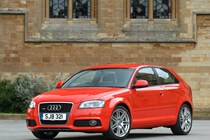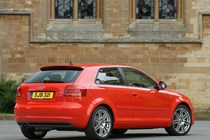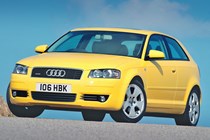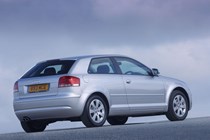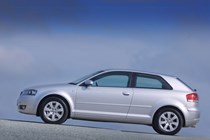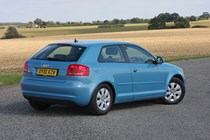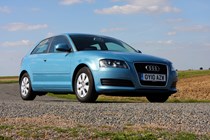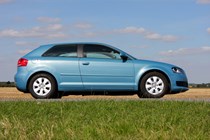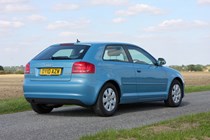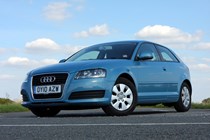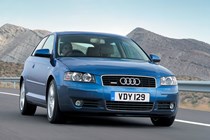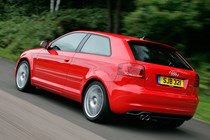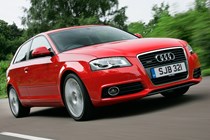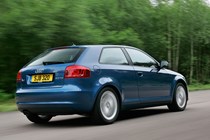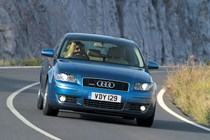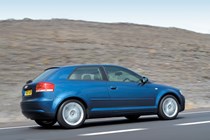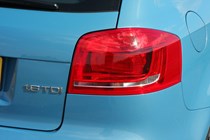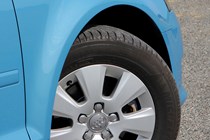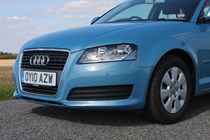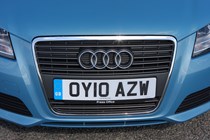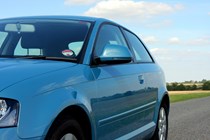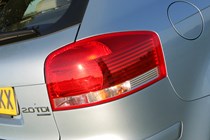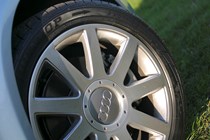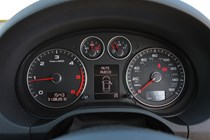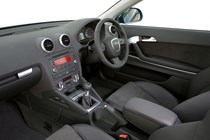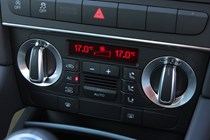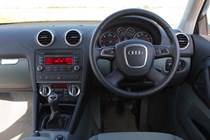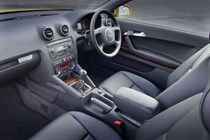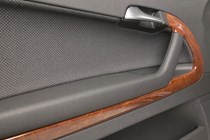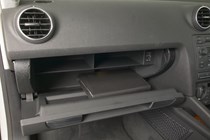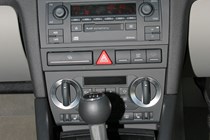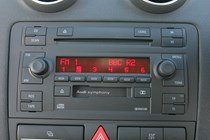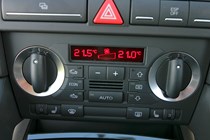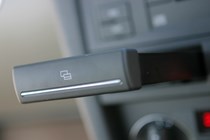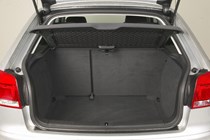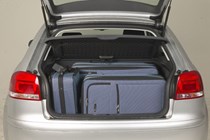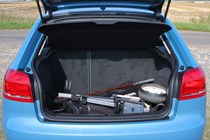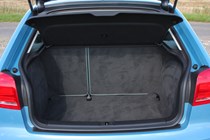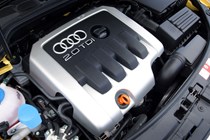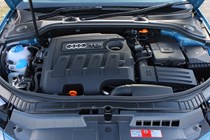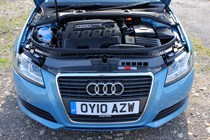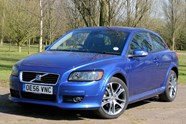Audi A3 Hatchback (2003-2012) review
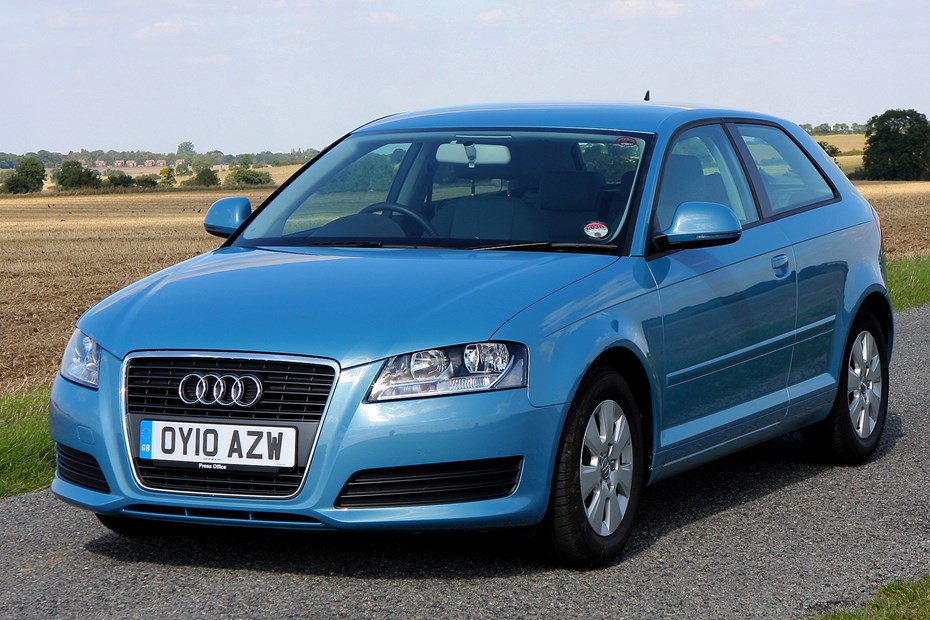
At a glance
| Price new | £14,825 - £27,925 |
|---|---|
| Used prices | £539 - £5,959 |
| Road tax cost | £20 - £760 |
| Insurance group | 14 - 36 |
Get an insurance quote with

|
|
| Fuel economy | Not tested to latest standards |
| Range | 315 - 895 miles |
| Number of doors | 3 |
| View full specs for a specific version | |
Available fuel types
Petrol
Diesel
Pros & cons
- Supreme build quality
- Efficient petrol engines
- Upmarket, sporty image
- Diesels fall foul of ULEZ
- Three door only (Sportback has five)
- Very basic if you don't find right options
Audi A3 Hatchback (03-12) rivals
Overview
The Audi A3 is one of the most popular used premium hatchbacks around, and is still a common sight in Britain’s towns and cities. Its success is particularly notable given the competition: BMW’s rear-wheel drive 1-Series and stylish Volvo C30 are just as relevant second hand buys, but outnumbered significantly by the long-lived Audi.
Relatively roomy and with class-leading build quality, the second generation Audi A3 (Typ 8P) is a desirable upmarket alternative to three-door versions of popular family hatchbacks as well – and that’s partly because it shares engineering with the class leader there, the Volkswagen Golf MkV. If you want a five-door version, the Audi A3 Sportback returned the family-friendly layout to the range in 2004 with an 80mm longer wheelbase and larger boot space.
In mid-2005 the Audi A3 was given a facelift to look more like the five-door Sportback version, with another facelift in 2008 carrying the range through until the third-generation, MQB-based Audi A3‘s introduction in 2012. Standard spec can be a little on the sparse side, so check your potential purchase has the options you want.
Audi A3 Mk2 (2003-2012) buying guide
The Audi A3 Mk2 essentially follows the engineering and diversity of Volkwagen Group’s smaller family cars, including the Golf, Leon and Octavia, but as a premium model has more upmarket trim and equipment – and a couple of high-end options such as a 3.2-litre V6 option, all-wheel drive branded as quattro, and advanced low-emission models. The shared platform and evolutionary tech means mechanics will generally be familiar with the Audi A3, and there are plenty of options for spares to keep it going on a budget – though higher-end models should not be neglected.
Audi parts prices can be expensive, so don’t gloss over electrical faults or broken trim on a prospective purchase. This guide does not cover the high performance Audi S3 or RS3 derivatives, and we would recommend getting an independent specialist to check those before purchase.
Pre-facelift models run from 2003 to 2005, and can be spotted at a glance by the divided upper and lower grille. The engine range was simplified with a focus on efficiency for the 2008-on models, and the full-depth grille matches that of the five-door Audi A3 Sportback. You’ll also find detail interior improvements and overall higher quality in a facelift model.
We would look for a post-2008, unmodified example with good history, and avoid diesel if you need to regularly go into clean air zones or within London’s ULEZ – but beyond that, the only A3 we’d actively avoid is the early 1.6-litre petrol – it’s simply outclassed by every other option, and not very economical.
Audi A3 Mk2 known faults and common problems
There are few flaws in the Audi A3’s proven front-wheel drive, Golf-derived formula so your attention should be on the overall condition, the MOT history, service records and paying the right price for your potential purchase. The A3 is a popular car and easy to sell, so it can attract dodgy dealers – here are some tips for avoiding scams.
1. Audi A3 Mk2 diesel engines
By far the most popular kind of Audi A3 when new, the diesel is now the hardest one to recommend both in terms of long-term ease of maintenance and the number of towns and cities which are introducing penalties based on emissions. As such, we would chose the 1.6-litre with 99g/km emissions if you want the cheapest VED, the 1.9-litre 105hp if you want the easiest maintenance, and the 2.0-litre 170hp if you want the best blend of economy and performance. This is also available with a DSG automatic gearbox and quattro.
There are anomalies within ULEZ records, such as imported cars and models which met emissions standards ahead of mandatory deadlines. While no diesel A3 is ULEZ exempt as far as we know, you should check the specific car you are looking at on the TfL website if the seller claims otherwise.
2. Audi A3 Mk2 petrol engines
Ignoring the S3 and RS3, the A3 can be found with four cylinder petrol engines in most models ranging from 100hp to 200hp, with a rare 3.2 V6 250hp model akin to VW’s Golf V6 4Motion. It uses the later VR6 engine that is generally well understood by specialists and reasonably reliable, though difficult to work on in this installation. Misfires and timing chain rattles can indicate a big bill purely because there’s so little room to work around it.
On all models look for timing belt replacement at the correct intervals, signs of oil and coolant mixing, and listen for misfires and poor running. The 1.6 100hp can use oil even when healthy and is not very economical, the 1.8-litre turbo is a straightforward choice that is easy to maintain and tune, and well known in the trade. You’ll find 2.0-litre and 3.2-litre versions with quattro.
1.2-litre models can suffer from timing chain wear, listen for rattles and dry, clattery sounds when driving with the windows open at low speeds, and at idle with the bonnet open.
3. Bodywork and rust resistance
Audi’s reputation for cars that don’t rust hasn’t kept A3s from doing so. Early ones rust on front wings and doors due to poor seals and sound deadening material, as the cars have aged rust on subframes, sills and arches has become a relatively common problem. Check thoroughly, though there are few hidden spots and a rusty A3 will generally be easy to spot at a glance. Check the boot floor and under the carpets for damp, it’s also a good place to check for accident damage
4. Gearbox – manual
A variety of manual gearbox types are fitted to the A3 depending on engine, including five- and six-speed versions. The clutch action is usually smooth and progressive, and the shift action should be positive, if not clicky-precise like a rear-wheel drive sportscar.
On diesel models in particular, listen for grumbles, crunching and feel for juddering when pulling away and changing gear. These can indicate failure of the dual-mass flywheel, which will make a routine worn clutch at high mileages considerably more expensive.
5. Gearbox – automatic
If you want a two-pedal Audi A3 you have two choices, a six-speed or seven-speed automatic. Both are dual-clutch, DSG, designs, but the six-speed is a stronger and more reliable unit overall. Both transmissions need regular oil changes, ideally no longer than 40,000 mile intervals, and may need recalibrating after servicing.
The seven-speed DSG, though branded S-tronic, received several updates during the life of the A3 – check that any service actions have been carried out.
6. Quattro – all wheel drive system
If you are looking at an Audi A3 quattro it can be difficult to determine that the system is working correctly unless you have a slippery surface to work with. Listen for clonks and feel for dragging or unexpected movement when accelerating through corners, and when parked, check all the tyres for uneven wear and scrubbing.
The Haldex system used is reliable if maintained properly, but you have twice the number of CV joints and driveshafts to consider in routine maintenance, a more complex exhaust system, and ideally the tyres should be replaced as a full set.
The main thing to look for is evidence that the Haldex unit has had a fluid change every 40,000 miles or less. You will also want to listen for clonks and rattles from the rear suspension, which is a more complex design than used on front wheel drive A3s.
7. Suspension
Depending on year and specification, Audi offers standard suspension, lowered ‘S-Line’ suspension, and an adaptive system using computer-controlled adjustable dampers. The latter is referred to as magnetic ride, and there’s a good chance that older, cheaper used cars that had it from the factory will have had it replaced with standard suspension or aftermarket sports kits.
Listen for rattles over uneven surfaces, clonks on speed bumps or drain covers, and feel for shifts in the steering and resistance when approaching full lock. These can indicate failure of bushes and top mount bearings. The ride on S-Line and aftermarket sports suspension may be quite harsh.
When checking underneath the car look for rust on the lower arms of the rear suspension. Old and aftermarket pressed steel parts can snap due to corrosion.
8. Climate control
Check that the digital displays, where fitted, have not lost any pixels. This is a good time to make sure the air conditioning works, including all fan speeds and vent positions, particularly on cars with climate control. Windows can fall off the runners, and the mechanism can fail – it’s a time consuming but straightforward repair due to the complex design of the doors.
9. Exterior trim and modifications
Examine the bumpers, wings and sills for damage. Plastic lights can discolour with age, this can usually be polished with a cheap kit, but check the beam alignment in case of damage particularly on high-spec cars. Aftermarket wheels will usually be okay given the popularity of the A3, but make sure it has good tyres. Chip tuning and other modifications are common, and make sure any engine transplant has a visible engine number and proof of purchase.
10. Infotainment
The A3 is from the crossover point of car interiors where technology began to get more sophisticated – a basic 1.6-litre model might still have manual windows and a cassette player, whereas the last models could feature a large sat nav and media interface. Aftermarket upgrades are common – there’s a huge difference in value between a high-end Alpine or Kenwood upgrade and the myriad unbranded Android head units, so don’t pay over the odds for inferior tech.
What’s the Audi A3 Mk2 like to drive?
Over the next few pages, we’ll review each aspect of the second generation Audi A3, taking into account its practicality, comfort, fuel economy and performance. If you’re short on time, you can also skip to our verdict page to see if we recommend the Audi A3 as a good used car.



